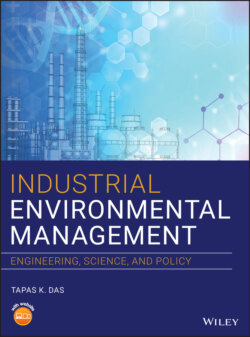Читать книгу Industrial Environmental Management - Tapas K. Das - Страница 26
1.8 Why Zero Discharge Is Critical to Sustainability
ОглавлениеTo understand why Zero Discharge is a critical component of sustainability, it is important to recognize that one principle of sustainability is the efficient and wise use of resources, especially with regard to limiting the amount and type of resource extraction and subsequent pollution loadings. To see how these are related, it may help to think of a cycle with three parts: sources, systems, and sinks.
The sources include raw materials such as minerals, water, topsoil, and fossil fuels. On this planet, these are limited but have huge external reserves.
The systems are our ability to manipulate energy to turn source materials into finished products. Economic and industrial systems are limited only by imagination.
The sinks are the global waste bins. The ultimate long‐term sink is the deep trenches of the oceans; short‐term sinks are biosystems such as the atmosphere, rivers, wetlands, and the land. The ability of the sinks to handle wastes is limited; most show adverse effects of pollutant loading in just a few years.
The most restricting rate‐limiting component in this three‐part model is the sinks. Currently, the depletion of resources is rarely the driving force for resource substitution; instead, change is driven by process innovation to beat the competition, or regulatory intervention imposed from outside. But given the limitations of the sinks, the pressure for modification of an industrial system will increasingly come from the need to reduce loadings to environmental sinks.
To achieve sustainability, the Earth's environment must be protected in multiple ways. For example, planners must aim to minimize or eliminate anthropogenic changes to climate, net increases in acidification, loses of topsoil, and withdrawals of fossil water; moreover, biodiversity must be preserved, and buildup of toxic metals and other nonbiodegradable toxics in soils or sediments must be stopped. Zero discharge technologies attempt to accomplish these goals by reducing resource extraction and loadings to sinks. The objective is a closed loop in the economic subsystem, so that wastes inevitably created by human activities do not escape to contaminate the environment. Zero Discharge/Emissions proponent Gunter Pauli, the founder and former director of Zero Emission Research Institute, also notes that in the effort to eliminate waste, Zero Emissions “is nothing more than a persistent drive to cut costs.” Waste is a form of inefficiency, and an “economic system cannot be considered efficient, or ultimately competitive, if it generates waste” (Pauli 1996).
Zero Discharge (or Emissions) leaves behind the linear “cradle to grave” concept of materials use (Figure 1.5) and embraces a cyclical, “cradle to cradle” vision (Figure 1.6), in which wastes become value‐added inputs and the raw materials for other production cycles. This is how natural systems dispose of waste, and according to Pauli, the only way to achieve sustainability.
Meanwhile, the biological sinks are not increasing in capacity. Existing industries will keep operating and generating wastes – some of these wastes, as will be discussed later, containing richer concentrations of recoverable materials than virgin ones. In the interim, there will be a demand for technologies to manage and convert today's wastes into usable feedstocks. Chemical process design engineers and consulting firms will provide focal services to meet this demand through technology development, system integration, and facility operation.
Figure 1.5 The interrelationship of sources, systems, and sinks for a linear (cradle to grave) materials use pattern.
Figure 1.6 The interrelationship of sources, systems, and sinks for a cyclic (Zero Emissions) materials use pattern.
